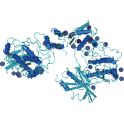
- Remove this product from my favorite's list.
- Add this product to my list of favorites.
Products
Newsletter
 |  |  |  |  |  |

Background: The p21-activated kinases (PAKs) belong to the group of serine/threonine protein kinases and are subdivided into two groups, PAK1-3 (group I) and PAK4-6 (group II), based on sequence similarities and an autoinhibitory domain which is present in group I, but not group II PAK. PAK1 is the most well characterized family member and is widely expressed but expression is significantly increased in ovarian, breast and bladder cancers. PAK1 plays an important role in cytoskeleton dynamics, in cell adhesion, migration, proliferation, apoptosis, mitosis, and in vesicle-mediated transport processes. PAKs in general have similar structural organization, including an N-terminal regulatory domain containing a p21 binding domain (PBD) (amino acids 67-113 in human PAK1) and an auto-inhibitory domain (AID) (amino acids 83-149 in human PAK1), overlapping partially with the PBD, and a C-terminal catalytic domain. The PBD domain is responsible for interaction with GTP bound members of the Rac and cdc42 family. Although PAK is a major downstream candidate of Rho family of GTPases, PAK can be activated by interaction with sphingolipids and their derivatives too. Additional, SH-3 containing adapter proteins such as Nck and Grb2 can interact with PXXP-motifs of the N-terminus of PAK1 following a recruitment to the plasma membrane resulting in PAK1 activation
Recombinant human PAK1 (amino acids M1-H545 as in GenBank entry NM_002576), N-terminally fused to GST-HIS6-Thrombin cleavage site
Theoretical MW : 90.5 kDa (fusion proteins)
Expression system: Sf9 cells
Purification: One-step affinity purification using glutathione agarose
Storage buffer: 50 mM Tris-HCl, pH 8.0; 100 mM NaCl, 5 mM DTT, 4 mM reduced glutathione, 20% glycerol
Storage temperature: - 80°C (avoid repeated freeze-thaw cycles !)
Protein concentration: 0.608 mg/ml (Bradford method using BSA as standard protein)
Method for determination of Km value & specific activity: Filter binding assay MAPH membrane
Specific activity: 386,000 pmol/mg min
Entrez Gene ID: 5058
UniProtKB: Q13153
Ordering information: shipped on dry ice
Kichina JV1, Goc A, Al-Husein B, Somanath PR, Kandel ES. (2010) "PAK1 as a therapeutic target."Expert Opin Ther Targets. 2010 (7):703-25.
Whale A, Hashim FN, Fram S, Jones GE, Wells CM. (2011) "Signalling to cancer cell invasion through PAK family kinases." Front Biosci (Landmark Ed). 1;16:849-64.
Wang J., Wu J.W., Wang Z.X. (2011) "Structural insights into the autoactivation mechanism of p21-activated protein kinase."Structure 19:1752-1761
Recombinant human Misshapen-like kinase 1 (MINK1), protein kinase domain, 10 µg - 465,00 €
Recombinant human Mammalian Sterile20-like kinase 1 (Mst1), 10 µg - 465,00 €
Recombinant human Mammalian STE20-like protein kinase 2 (MST2), 10 µg - 465,00 €
Recombinant human Mammalian STE20-like protein kinase 4 (MST4), 10 µg - 465,00 €
Welcome Login
Contact us
Follow us